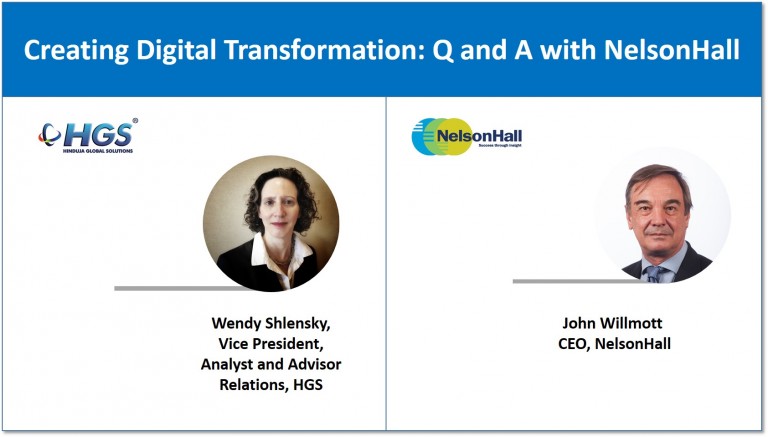posted on Jun 09, 2016 by Paul Connolly
This week, HGS announced the launch of their DigiCX suite of digital solutions, which integrates web self-service, live support via chat, text, social media, and voice, and optimizes the CX with analytics and automation. When it embarked on this latest phase in its development a year and a half ago, HGS consulted NelsonHall “to help validate our direction, sharpen our solution approach, and fine tune our differentiated market proposition”. Here, John Willmott, NelsonHall’s CEO, answers questions from Wendy Shlensky of HGS, sharing some of the insights that helped guide them in providing their clients with digital transformation and optimized CX.
Wendy Shlensky, Vice President, Analyst and Advisor Relations for HGS, says “Today we’re getting global brands up and running on digital platforms with integrated digital agents in as little as 90 days with pilots that are designed to incubate best approaches to empower customers to help themselves. And we enlisted the best-of-the-best guidance to do it right – we shared ideas with and listened to expert analysts at NelsonHall.”

Wendy: Can you share trends you’ve seen in customer service?
John: Customer service was once viewed as an operational overhead, with the focus on cost reduction and minimizing handling times. But customer service has now become strategic within the organization with the emphasis on customer experience improvement and revenue generation. This is reflected in the rapidly increasing adoption of the chief customer experience officer role within major organizations.
Wendy: What is now driving new levels of urgency in customer service transformation?
John: It’s a combination of new technologies that support the customer need for instant information and service, and the emergence in recent years of disruptive, “digital” competitors in many sectors. At the same time, a new breed of consumers has emerged that principally communicates or transacts using smart phones. These customers compare CX across different verticals and expect the same level of service that they receive from Amazon, Apple, Zappos, or their local coffee shop from all brands. Millennials and Gen X consumers in particular are digital natives; lacking online channels, level of self-service or social media presence makes a brand non-existent for these segments.
According to a recent NelsonHall study, nearly three-quarters of major organizations globally are developing their position as “digital enterprises” in 2016, with two-thirds looking to develop new ways of doing business to compete with the new digital disruptors in their industry sector. Customer service is a key element in this re-positioning and transformation.
In particular, customers expect to be able to use their preferred channel for each outreach and to receive information or responses via a favored or most appropriate channel. Accordingly, customer service needs to be consistent and flexible across channels, increasingly involving two-way communication within each channel and switching between channels during a single interaction.
Personalization is also very important. Customers share enormous amounts of personal information online. They expect their brands to remember preferences, provide personalized offers, and be proactive.
Wendy: How essential are digital CX tools in today’s marketplace?
John: Digital CX tools are absolutely vital in today’s marketplace to assist organizations in making the transition from voice-centric customer service to a fully digital environment.
In particular, a set of digital CX tools is required to provide support for each digital channel. For example, self-serve, chat (in its various forms), and text require a separate module both to provide the appropriate functionality for that channel as it is deployed and to integrate it within the wider CRM and multichannel environment.
Additionally, digital tools are important in establishing a unified view of the customer across channels and systems of record, while analytics and AI supported by a digital knowledgebase are becoming increasingly important in presenting customers with the most appropriate channel and content and, in the future, playing a much more direct role in recommending next best actions both to customer service agents and through virtual agent support.
Access to multiple tools from assisted/automated chat to self-help videos becomes a must for a brand that competes with web-only brands. Ideally, each of these tools needs to be deployable as a separate system of engagement wrapping around existing systems of record.
Wendy: Is BPO service delivery on the increase? If so, why?
John: Perhaps surprisingly, given the increasing deflection of customer service to lower-cost-per-transaction digital channels, the customer management services market has seen an increase in growth rates in recent years.
There are a number of factors driving this growth:
- The growth in the number of digital channels has led to an increase in the absolute number of interactions, even though these interactions tend to be at a lower cost point than traditional voice interactions.
- Organizations are increasingly focusing on enhancing business outcomes, such as NPS and revenue generation and downplaying the importance of SLAs such as AHT, leading to higher value and lengthier voice calls, often with a greater onshore component.
- The move from voice-centric customer service to digitally enabled multi-channel customer service requires expertise in identifying appropriate roadmaps and customer journeys, supported by technology implementation expertise, which may be areas where organizations require external knowledge and assistance.
- The increasingly propensity for vendors to offer BPaaS approaches to digital CX means that outsourcing offers OPEX options linked to numbers of transactions or business outcomes rather than up-front capital expenditure, which can be financially attractive to organizations.
Wendy: What’s the future of digital BPO?
John: In the short term, buyers will look for digital CX transformation ability, which includes access to both talent and tools, while preserving their existing investments in systems. Channel adoption will tend to be incremental in nature.
In the longer term, analytics and AI have considerable roles in personalizing customer service and offers for individual consumers and automatically enhancing individual customer journeys within an integrated multi-channel environment.
Digital BPO will also become increasingly integrated across the value chain even potentially interfacing via IoT with consumer and household devices and delivery drones.
To find out more about the work NelsonHall is doing in the area of digital transformation, contact Guy Saunders.

